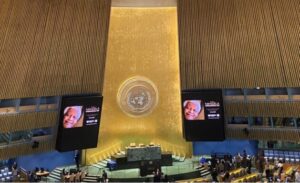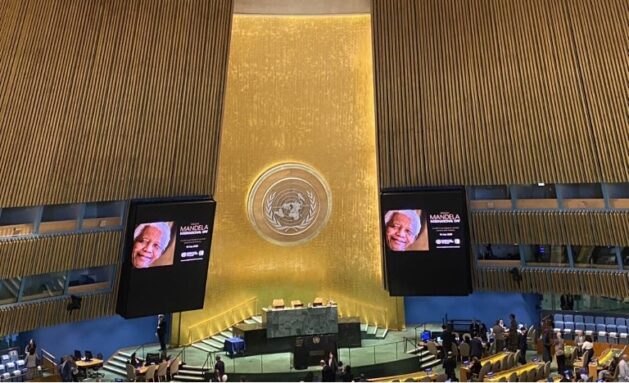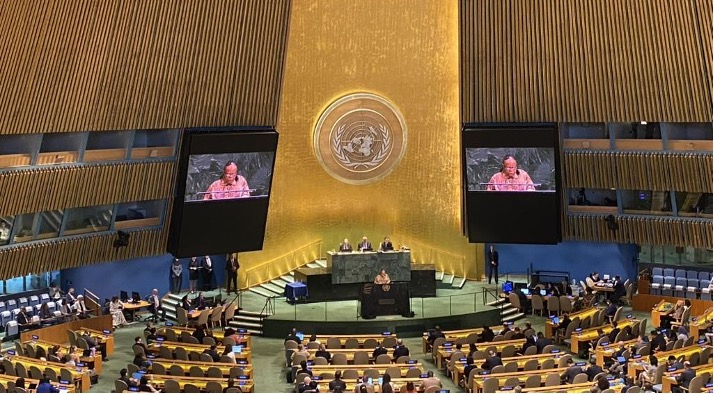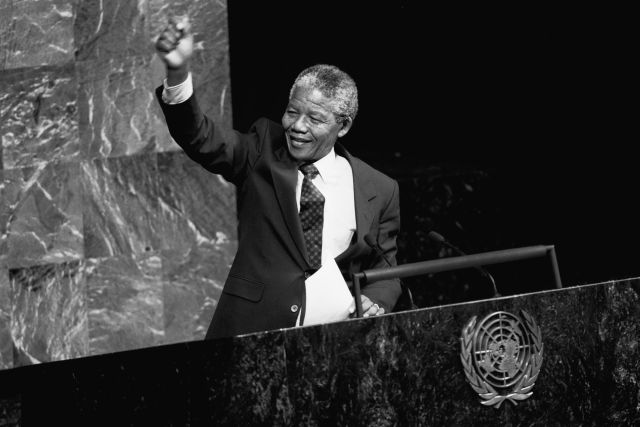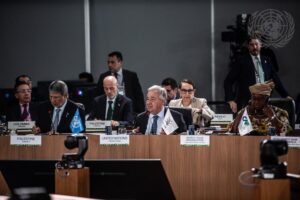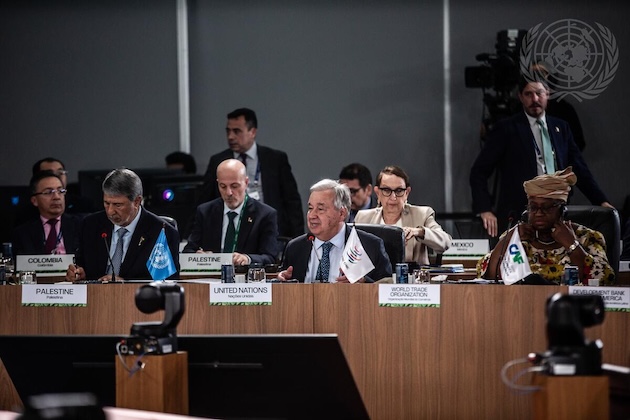
Active Citizens, Civil Society, Conferences, Development & Aid, Featured, Gender, Gender Violence, Global, Headlines, Human Rights, Population, Sustainable Development Goals, TerraViva United Nations, Women & Economy, Women in Politics

UN Women’s Executive Director, Sima Bahous, at a 2025 UN High-Level Political Forum on Sustainable Development side event. Credit: Naureen Hossain/IPS
– Discriminatory laws and the absence of legal protections impact more than 2.5 billion women and girls worldwide in various ways. Legal reform is paramount to securing gender equality, and the world cannot afford to roll back on decades of progress in women’s rights.
On the sidelines of the 2025 High-Level Political Forum on Sustainable Development on July 17, Equality Now and UN Women, with their partners the International Development Law Organization (IDLO), the Global Campaign for Equality in Family Law, the Global Campaign for Equal Nationality Rights (GCENR), Inter-parliamentary Union (IPU), hosted an official side event, “Accelerating Law Reform to Keep the Promise of Beijing, the SDGs, and the Pact for the Future.”
The purpose of the event was to spotlight the success in ending discrimination through the passing of robust, inclusive legislation and acknowledging the work that remains in combatting legal discrimination against women and girls. Bringing together stakeholders across the public sector and nongovernmental organizations, the event highlighted the relevance of global agreements that center on sustainable development and uphold international law, Equality Now Executive Director Mona Sinha pointed out.
“It is ever more urgent in these times of backlash against gender equality that the right to equality on the basis of sex as a fundamental human right is protected and promoted by States and the international community,” said Sinha.
“At UN Women, we are proud to lead a global strategy to achieve equality in law for women and girls by 2030 with our partners… We are racing against time to repeal discriminatory laws and to replace them with protections rooted in dignity and equality,” said UN-Women Executive Director Sima Bahous.
The event coincided with the launch of a joint publication from Equality Now and GCENR ‘Select Draft Articles on Nationality Rights to Ensure Gender Equality.’
The publication is intended to be used by policymakers as guidelines for drafting inclusive policies that enshrine protections for nationality rights for women and their children and partners. This was spotlighted as a persistent form of discrimination that restricts certain rights by virtue of their identity.

Panelists at the Equality Now side event at the 2025 UN High-Level Political Forum on Sustainable Development. Credit: Naureen Hossain/IPS
Catherine Harrington, Campaign Manager of the Global Campaign for Equal Nationality Rights, remarked on the “utter injustice” that men should have the “inherent right” to pass down nationality to their child or spouse, but women are not granted the same.
There are 24 countries where women legally cannot pass down their citizenship to their child, and at least 40 countries where women cannot confer the rights of citizenship to a non-citizen spouse. Such restrictions prevent impacted people from exercising other fundamental rights, including access to education, healthcare and even the right to enter the country they were born in or consider home.
The fight over equal nationality rights is emblematic of the broader issue of gender equality, as it demonstrates how a lack of legal protections can leave people vulnerable to having their rights denied or exploited.
“What does it say about women’s status as citizens and their equality in the family when the law that establishes the very foundation of political personhood, citizenship, holds that men naturally have the right to pass citizenship as full citizens and women do not and are not deserving of the same?” said Harrington. “What does it mean to be committed to combating gender-based violence when we know that gender discriminatory laws are linked with multiple forms of GBV and contribute to the root cause of gender-based violence, which is women’s unequal status in society?”
Women’s participation in public spaces, including politics, is also a measure of gender equality and a step toward sustainable development. A report from UN Women stated that while there was a boost in the proportion of women in parliament, as countries had taken steps to boost women’s participation in national and local legislatures, such as with gender quotas, three out of four parliamentarians were still men. These environments need to be created to be gender-inclusive and safe to ensure women’s participation. As long as the institutions that are meant to represent the people are shaped by laws that only benefit a select few, there is no room for equality.
“Democracy cannot be credible or effective if it does not reflect the diversity of people,” said Paddy Torsney, Inter-Parliamentary Union (IPU) Permanent Observer to the UN. Tornsey remarked that fostering inclusive political environments allows women the “power, protection and the platform to lead.” These environments can be created through inclusive policies and a zero tolerance for gender-based violence in all forms.
Effective, inclusive legislation can only be driven by “reliable data,” according to Hikaru Yamagishi from the World Bank. Yamagishi added that through the Women, Business and Law Project, the World Bank has provided “comprehensive, comparable data” on how laws affect women’s jobs to lawmakers across 190 economies.
Among their findings was that although women have 64 percent of the rights of men, economies have less than 40 percent of the systems in place needed to implement those rights in practice. This indicates a ‘significant’ implementation gap, Yamagishi said, between formal legislation and what women actually experience in real life.
“This implementation gap must be tracked alongside legal [gaps]. The Women Business and Law report evidences the importance of legal reforms like banning discrimination… but it also shows that those reforms only go so far without supportive policies,” she added.
The event brought together representatives from member states to share how their countries dealt with eliminating discrimination through legal reform. In the Kyrgyz Republic, steps were taken to reform the labor code, including 400 professions that were previously restricted from women.
Bakyt Sydykov, Minister of Economy and Commerce of the Kyrgyz Republic, remarked on federal programs that boosted employment opportunities for women living in rural areas. Along with civil society and trade unions, international partners like UN Women and the International Labour Organization (ILO) consulted the country’s legislative reform in ensuring equal employment opportunities.
“We believe that Kyrgyzstan’s experience can offer a useful reference point for other countries where similar challenges arise,” said Sydykov. “Our approach shows that when reforms stem from nationwide dialogue and international standards, implemented in partnership with all segments of society, they can succeed.”
“As a country that has elected two women to the highest position in the government, the Philippines can confidently say that gender equality is robust and highly needed in our society. However, there are still areas for improvement along the way,” said Noel Mangaoang Novicio, Minister, Permanent Mission of the Philippines to the UN. Novice cited his country’s Magna Carta of Women, adopted in 2009, a comprehensive human rights law for women that is based on the principles of international law.
These examples demonstrate that widespread gender equality is achievable. Nevertheless, no country has achieved true gender parity, so it remains an ongoing effort. This also shows the importance of partnerships across multiple sectors and stakeholders. Governments can enforce legal reforms on a wide scale, the private sector can advocate for reforms and lead by example, and multinational organizations such as the UN and the World Bank have the resources to provide evidence of where change is needed and bring stakeholders together.
“When we work together to make legal equality a reality, it unlocks economic potential and fuels inclusive progress,” said Yamagishi.
The event, which included youth advocates and representatives from around the world among its attendees, demonstrated one of the UN’s roles in a microcosm: a convening body that brings together governments, civil society and experts on a global stage to drive forward shared commitments.
Antonia Kirkland, Equality Now’s Global Lead, Legal Equality and Justice, remarked that this makes the UN “an indispensable force in pushing for transformative, rights-based legal reforms worldwide.”
“By amplifying the voices of women’s rights advocates, particularly those from the Global South, UN platforms provide an opportunity to elevate grassroots demands to the international level, to influence legal and policy change. The UN provides an essential space for peer accountability, shared learning, and collective pressure that no single organization or government could generate alone,” said Kirkland.
Kirkland explained to IPS the ‘uniquely powerful’ role the UN and its agencies play in promoting legal reforms for gender equality. The UN has helped to set international legal standards, and its treaties and special mechanisms provide the frameworks to hold members accountable and call them out on legal discrimination.
With that said, the UN must continue its support and wield its influence amidst increasing attacks from anti-rights movements that threaten to reverse the progress on women’s legal rights.
Kirkland told IPS that anti-gender equality and anti-rights movements have been working to “erase or dilute the concept of ‘gender’ from UN documents, negotiations, and frameworks.” Erasing gender-inclusive language risks undermining international human rights standards and further weakening accountability for gender-based violence and discrimination and marginalizing the diverse experiences of women and girls.
Therefore, the UN needs to strengthen its monitoring and enforcement mechanisms for international commitments such as CEDAW and the Sustainable Development Goals (SDGs) and use its platforms to publicly track progress in legal reform. This will also require the support of member states through reaffirming their international commitments and through sustained funding to the UN.
“At a time of rising authoritarianism and anti-rights backlash, a strong, well-resourced UN is essential. Governments also need to enhance and defend the UN’s legitimacy in multilateral forums and resist political efforts to weaken its role in protecting rights and holding states accountable,” Kirkland said.
“Let us invest in feminist leadership. Let us enshrine equality, not only in our speeches, but in our statutes and in our actions,” Bahous said in her closing remarks. “The law must not be a tool of oppression. It must be the first guarantee of justice. Only when we achieve equality for all women and girls under the law can we get back on track to the SDGs, and SDG 5 [Gender Equality] remains our docking station upon which all SDGs depend.”
IPS UN Bureau Report

